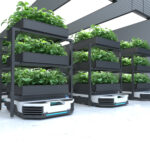Currently, the least populated regions of Spain have a population of approximately 0.98 inhabitants per square kilometre, and this situation is of great concern to European institutions, which are promoting initiatives that encourage the application of technological solutions in the area of agriculture, often relying on the IoT (Internet of Things). The potential of the rural regions is such that they can be a solution to the so-called “fourth industrial revolution”. In the times of a hollowed-out Spain, it is essential to set standard directions to achieve group objectives that will result in personal benefits.
One of Europe’s concerns is that all regions should have the same opportunities, not only those that have been more developed. At this point, it is important to highlight areas that are not only peripheral but also border areas. For example, when we talk about the west of Spain and the centre of Portugal, it is clear that they require additional measures that allow them to access the digitalisation of their production processes.
Peripheral and border areas need to fight against the so-called Context Costs. These costs are defined as those derived from the application of provisions established in regulations or other legal instruments, whose control corresponds exclusively to governmental or public entities or institutions and whose application includes the border territory between Spain and Portugal. It is essential to highlight that the so-called Industry 4.0 is driving the growth and transformation of various sectors such as food and agriculture thanks to artificial intelligence, immersive reality, the Blockchain, IoT, big data, digital transformation, etc. These tools are creating an ecosystem from which small livestock farmers, farmers and other sectors in rural areas can benefit, especially on borders such as the Spanish-Portuguese border, where Context Costs are historically established.
The border territory between Spain and Portugal is characterised by a high incidence of primary sub-sectors such as agriculture and livestock farming. The agricultural and livestock activities can take advantage of implementing technological tools due to their great potential for development in rural areas. But to implement them, it is necessary to
- Generate infrastructures prepared to support R&D.
- Create a commercial technology network to support innovation, research and development.
The great potential of implementing technology in these less populated areas (especially in the area of agriculture, tourism and livestock) comes from the fact that by industrialising processes in these areas, new jobs will be generated, contributing to the movement of skilled labour to these areas, which would reduce depopulation and give them a second chance.
Specifically, for agriculture to become a more sustainable sector, conserving our resources and the environment’s biodiversity must manage rural resources as efficiently as possible, making IoT an essential tool in rural areas.
Livestock and agriculture are the sectors that will have the most significant opportunity to benefit from the technology. Access to different data sources enables timely decisions and the creation of automated and intelligent processes in agricultural activities. This will lead to the revaluation of the sector, making it more profitable and attractive to the population, thus promoting population growth.
Farmers who want to know the ideal time to sow or harvest or wish to be informed about the actual state of their crops (humidity, temperature, soil toxicity, fertilisation, etc.) can find their best ally in sensitisation. Suppose they also want to take action quickly. In that case, they can automate the processes on their farms and control them via their smartphone, saving time and money and achieving significant improvements in product quality.
Farmers can also benefit significantly from the technology. Herds can be monitored using sensors and connectivity tools that allow them to keep track of animals (feeding, health, etc.) and locate them.
Implementing new technologies opens up great opportunities for job creation and thus wealth generation. However, the sensitisation of processes brings potential security problems, so users and companies must invest in cybersecurity systems, VPNs, intrusion detection systems, etc.








